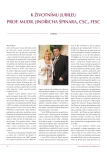Catheter closure of PFO and paradoxical systemic embolisation
Authors:
P. Kala; M. Poloczek; T. Brychta; S. Nehyba; V. Chaloupka
Authors‘ workplace:
Interní kardiologická klinika FN Brno
Published in:
Kardiol Rev Int Med 2010, 12(2): 84-87
Overview
Patent foramen ovale (PFO) is a common finding in the adult population. As it serves as a potential pathway for paradoxical systemic embolisation, it plays a pathophysiological role in various diseases. After exclusion of other known causes, catheter closure is a safe and effective procedure indicated most frequently in stroke patients, although it can also be used in secondary prevention of decompression illness, systemic embolisation into other organs etc. Therefore, the final diagnosis of cryptogennic stroke or TIA should be done only when the traditional risk factors, such as paradoxical embolisation in PFO, atrial septal defect or pulmonary shunts have been excluded. The results of multicentre randomized trials comparing pharmacological and catheterbased PFO treatment in stroke/TIA patients should be available during 2011.
Keywords:
patent foramen ovale – catheter closure – stroke – paradoxical embolisation
Sources
1. Sacco RL, Ellenbereg JH, Mohr JP et al. Infarcts of undetermined cause: the NINCDS Stroke Data Bank. Ann Neurol 1989; 25: 382–390.
2. Mohr JP, Thompson JL, Lazar RM et al. Warfarin– Aspirin Recurrent Stroke Study Group. A comparison of warfarin and aspirin for the prevention of recurrent ischemic stroke. N Engl J Med 2001; 345: 1444–1451.
3. Mohr JP. Cryptogenic stroke. N Engl J Med 1988; 318: 1197–1198.
4. Cohnheim J. Thrombose und embolie. Vorlesung über allgemeine Pathologie. Berlin: Hirschwald 1877; 1: 134.
5. Lechat P, Mas JL, Lascault G et al. Prevalence of patent foramen ovale in patients with stroke. N Engl J Med 1988; 318: 1148–1152.
6. Parsons FG, Keith A. Seventh report of the Committee of Collective Investigation of the Anatomical Society of Great Britain and Ireland, 1896–97. J Anat Physiol 1897; 32: 164–186.
7. Hagen PT, Scholz DG, Edwards WD. Incidence and size of patent foramen ovale during the first 10 decades of life: an autopsy study of 965 normal hearts. Mayo Clin Proc 1984; 59: 17–20.
8. Webster MW, Chancellor AM, Smith HJ et al. Patent foramen ovale in young stroke patients. Lancet 1988; 2: 11–12.
9. Hausmann D, Mügge A, Becht I et al. Diagnosis of patent foramen ovale by transesophageal echocardiography and association with cerebral and peripheral embolic events. Am J Cardiol 1992; 70: 668–672.
10. Van Camp G, Schulze D, Cosyns B et al. Relation between patent foramen ovale and unexplained stroke. Am J Cardiol 1993; 71: 596–598.
11. Meier B. Catheter–Based Closure of the Patent Foramen Ovale. Circulation 2009; 120: 1837–1841.
12. Mareedu RK, Shah MS, Mesa JE et al. Percutaneous Closure of Patent Foramen Ovale: A Case Series and Literature Review. Clinic Med Res 2007; 5: 218–226.
13. King TD, Thompson SL, Steiner C et al. Secundum atrial septal defect. Nonoperative closure during cardiac catheterization. JAMA 1976; 235: 2506–2509.
14. Bridges ND, Hellenbrand W, Latson L et al. Transcatheter closure of patent foramen ovale after presumed paradoxical embolism. Circulation 1992; 86: 1902–1908.
15. Wahl A, Meier B. Patent foramen ovale and ventricular septal defect closure. Heart 2009; 95: 75–82.
16. Poloczek M, Kala P, Brychta T et al. Katetrizační uzávěry na mezisíňovém septu – roční follow-up. XVII. výroční sjezd České kardiologické společnosti 2009.
17. Wahl A, Tai T, Praz F et al. Late results after percutaneous closure of patent foramen ovale for secondary prevention of paradoxical embolism using the amplatzer PFO occluder without intraprocedural echocardiography: effect of device size. JACC Cardiovasc Interv 2009; 2: 116–123.
Labels
Paediatric cardiology Internal medicine Cardiac surgery CardiologyArticle was published in
Cardiology Review

2010 Issue 2
Most read in this issue
- Catheter closure of PFO and paradoxical systemic embolisation
- Transcranial colour-coded duplex sonography to evaluate intracranial arteries in patients with cerebrovascular stenooclusive disease – review
- Primary hyperaldosteronism: the most common form of secondary hypertension
- Hypertension treatment in patients with metabolic syndrome
